light YAMAHA XT1200Z 2013 Owner's Guide
[x] Cancel search | Manufacturer: YAMAHA, Model Year: 2013, Model line: XT1200Z, Model: YAMAHA XT1200Z 2013Pages: 108, PDF Size: 2.86 MB
Page 77 of 108
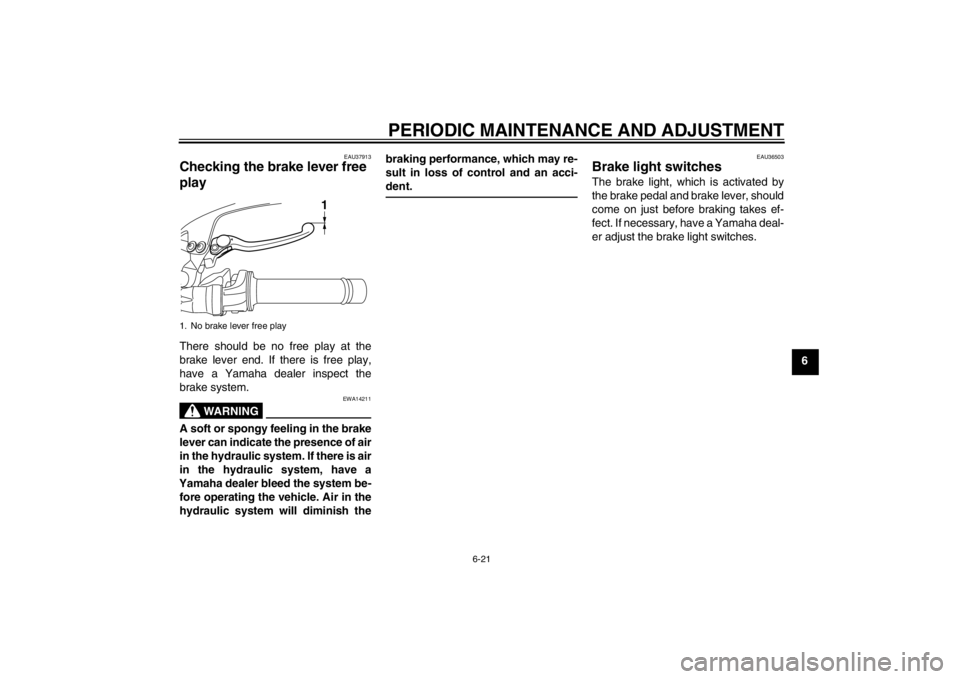
PERIODIC MAINTENANCE AND ADJUSTMENT
6-21
6
EAU37913
Checking the brake lever free
play There should be no free play at the
brake lever end. If there is free play,
have a Yamaha dealer inspect the
brake system.
WARNING
EWA14211
A soft or spongy feeling in the brake
lever can indicate the presence of air
in the hydraulic system. If there is air
in the hydraulic system, have a
Yamaha dealer bleed the system be- fore operating the vehicle. Air in the
hydraulic system will diminish the braking performance, which may re-
sult in loss of control and an acci-
dent.
EAU36503
Brake light switches The brake light, which is activated by
the brake pedal and brake lever, should
come on just before braking takes ef-
fect. If necessary, have a Yamaha deal-
er adjust the brake light switches.
1. No brake lever free play
1
U23PE3E0.book Page 21 Monday, July 30, 2012 8:44 AM
Page 86 of 108
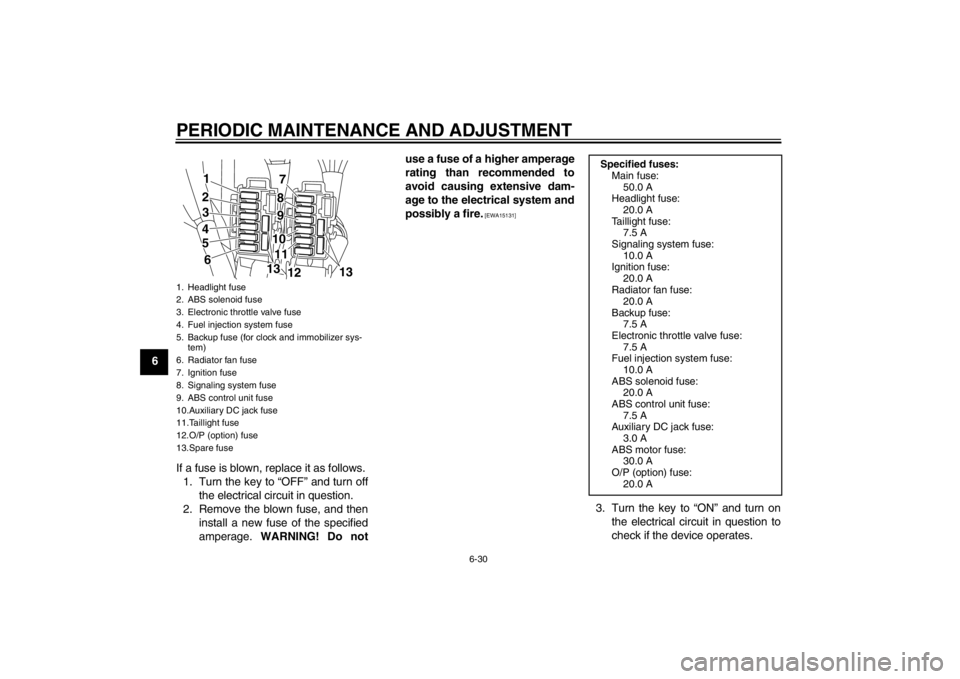
PERIODIC MAINTENANCE AND ADJUSTMENT
6-30
6If a fuse is blown, replace it as follows.1. Turn the key to “OFF” and turn off the electrical circuit in question.
2. Remove the blown fuse, and then install a new fuse of the specified
amperage. WARNING! Do not use a fuse of a higher amperage
rating than recommended to
avoid causing extensive dam-
age to the electrical system and
possibly a fire.
[EWA15131]
3. Turn the key to “ON” and turn on
the electrical circuit in question to
check if the device operates.
1. Headlight fuse
2. ABS solenoid fuse
3. Electronic throttle valve fuse
4. Fuel injection system fuse
5. Backup fuse (for clock and immobilizer sys-tem)
6. Radiator fan fuse
7. Ignition fuse
8. Signaling system fuse
9. ABS control unit fuse
10.Auxiliary DC jack fuse
11.Taillight fuse
12.O/P (option) fuse
13.Spare fuse
78912
13
13
1110
124563
Specified fuses: Main fuse:
50.0 A
Headlight fuse:
20.0 A
Taillight fuse: 7.5 A
Signaling system fuse: 10.0 A
Ignition fuse:
20.0 A
Radiator fan fuse: 20.0 A
Backup fuse: 7.5 A
Electronic throttle valve fuse:
7.5 A
Fuel injection system fuse: 10.0 A
ABS solenoid fuse: 20.0 A
ABS control unit fuse:
7.5 A
Auxiliary DC jack fuse: 3.0 A
ABS motor fuse: 30.0 A
O/P (option) fuse:
20.0 A
U23PE3E0.book Page 30 Monday, July 30, 2012 8:44 AM
Page 87 of 108
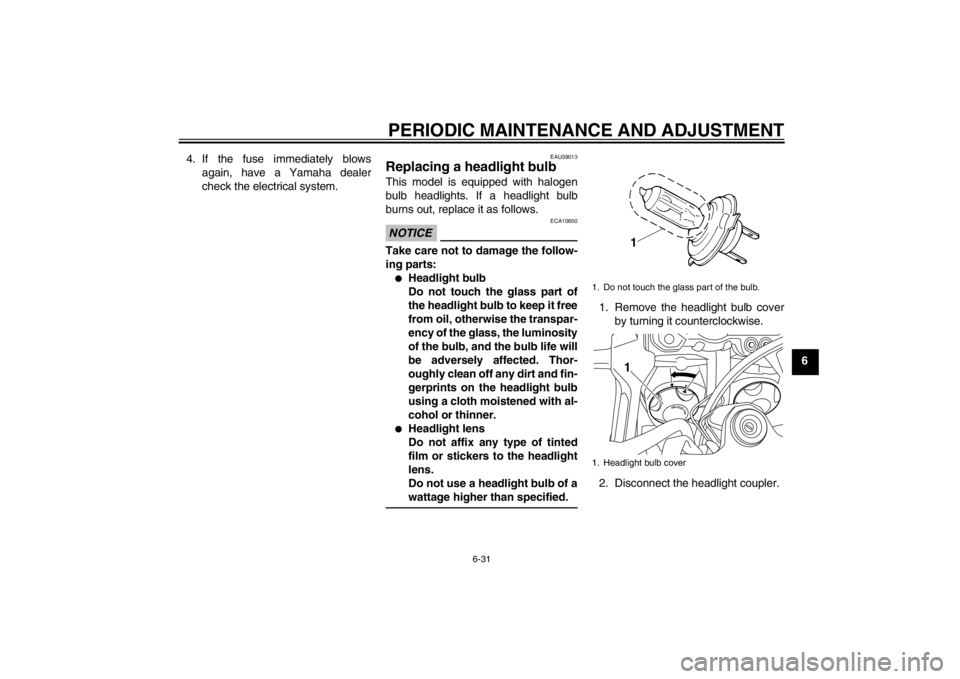
PERIODIC MAINTENANCE AND ADJUSTMENT
6-31
6
4. If the fuse immediately blows
again, have a Yamaha dealer
check the electrical system.
EAU39013
Replacing a he adlight bulb This model is equipped with halogen
bulb headlights. If a headlight bulb
burns out, replace it as follows.NOTICE
ECA10650
Take care not to damage the follow-
ing parts:●
Headlight bulb
Do not touch the glass part of
the headlight bulb to keep it free
from oil, otherwise the transpar-
ency of the glass, the luminosity
of the bulb, and the bulb life will
be adversely affected. Thor-
oughly clean off any dirt and fin-
gerprints on the headlight bulb
using a cloth moistened with al-
cohol or thinner.
●
Headlight lens
Do not affix any type of tinted
film or stickers to the headlight
lens.
Do not use a headlight bulb of a
wattage higher than specified.
1. Remove the headlight bulb cover
by turning it counterclockwise.
2. Disconnect the headlight coupler.1. Do not touch the glass part of the bulb.
1. Headlight bulb cover
1
U23PE3E0.book Page 31 Monday, July 30, 2012 8:44 AM
Page 88 of 108
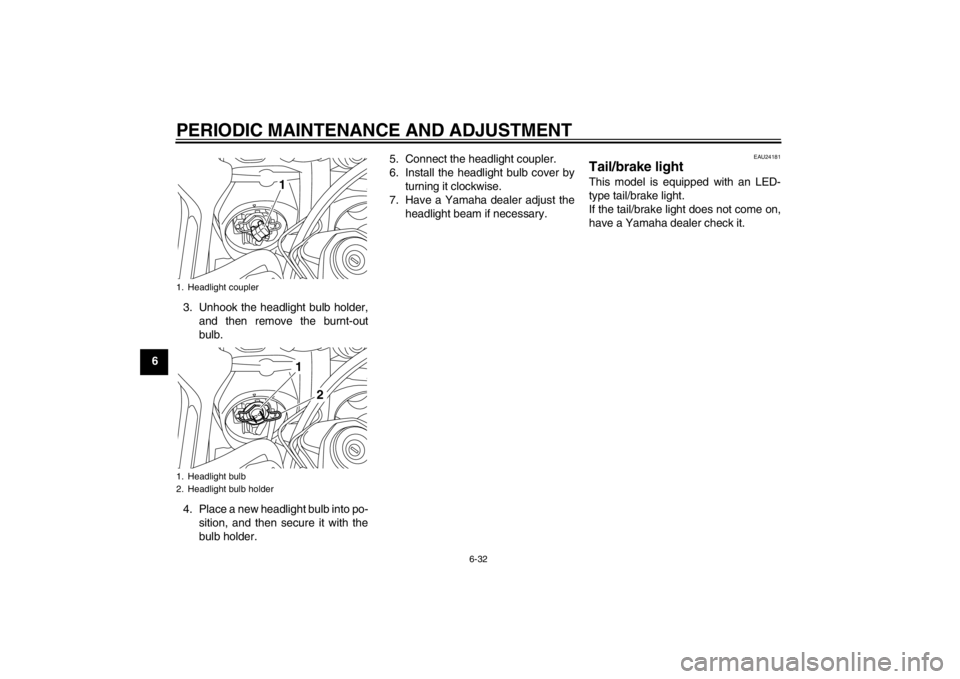
PERIODIC MAINTENANCE AND ADJUSTMENT
6-32
63. Unhook the headlight bulb holder,
and then remove the burnt-out
bulb.
4. Place a new headlight bulb into po- sition, and then secure it with the
bulb holder. 5. Connect the headlight coupler.
6. Install the headlight bulb cover by
turning it clockwise.
7. Have a Yamaha dealer adjust the headlight beam if necessary.
EAU24181
Tail/brake light This model is equipped with an LED-
type tail/brake light.
If the tail/brake light does not come on,
have a Yamaha dealer check it.
1. Headlight coupler
1. Headlight bulb
2. Headlight bulb holder
1
1
2
U23PE3E0.book Page 32 Monday, July 30, 2012 8:44 AM
Page 89 of 108
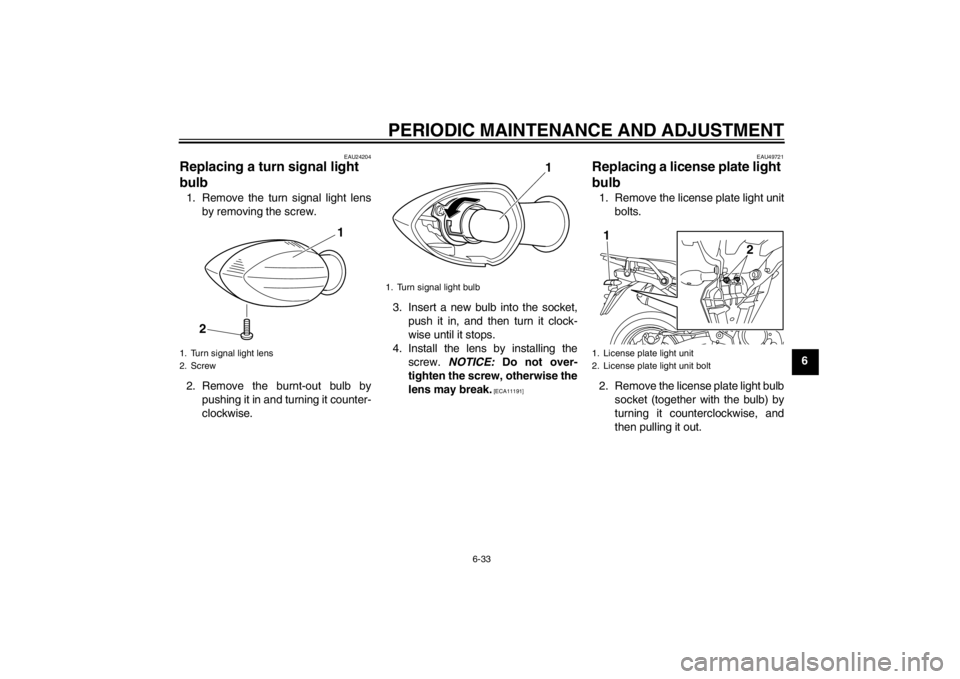
PERIODIC MAINTENANCE AND ADJUSTMENT
6-33
6
EAU24204
Replacing a turn signal light
bulb 1. Remove the turn signal light lensby removing the screw.
2. Remove the burnt-out bulb by pushing it in and turning it counter-
clockwise. 3. Insert a new bulb into the socket,
push it in, and then turn it clock-
wise until it stops.
4. Install the lens by installing the screw. NOTICE: Do not over-
tighten the screw, otherwise the
lens may break.
[ECA11191] EAU49721
Replacing a license plate light
bulb 1. Remove the license plate light unit
bolts.
2. Remove the license plate light bulb socket (together with the bulb) by
turning it counterclockwise, and
then pulling it out.
1. Turn signal light lens
2. Screw
1
2
1. Turn signal light bulb
1
1. License plate light unit
2. License plate light unit bolt
2
1
U23PE3E0.book Page 33 Monday, July 30, 2012 8:44 AM
Page 90 of 108
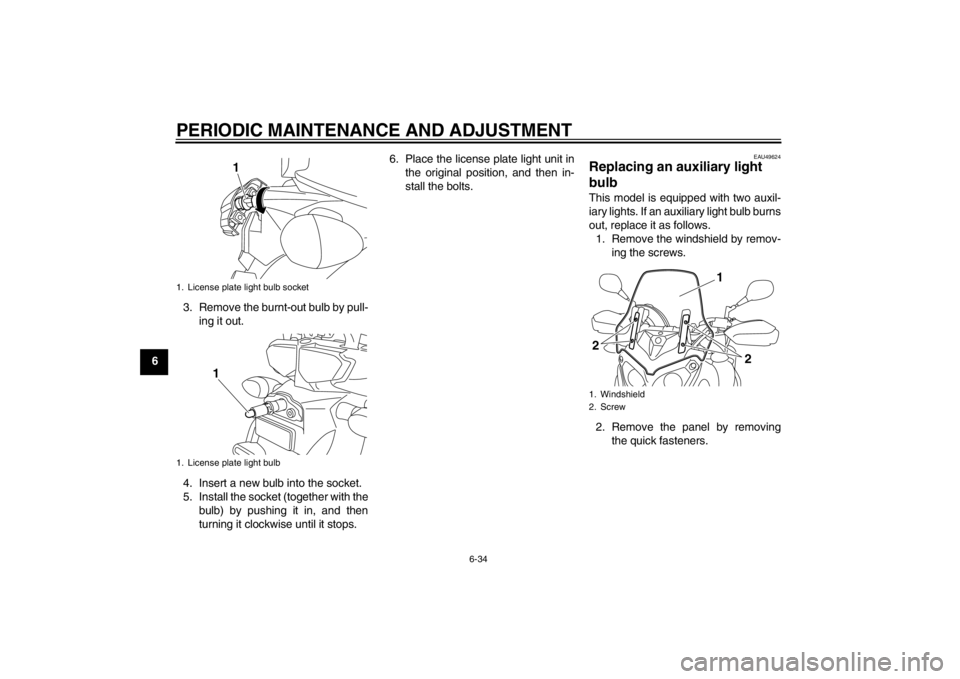
PERIODIC MAINTENANCE AND ADJUSTMENT
6-34
63. Remove the burnt-out bulb by pull-
ing it out.
4. Insert a new bulb into the socket.
5. Install the socket (together with the bulb) by pushing it in, and then
turning it clockwise until it stops. 6. Place the license plate light unit in
the original position, and then in-
stall the bolts.
EAU49624
Replacing an auxiliary light
bulb This model is equipped with two auxil-
iary lights. If an auxiliary light bulb burns
out, replace it as follows.1. Remove the windshield by remov- ing the screws.
2. Remove the panel by removing the quick fasteners.
1. License plate light bulb socket
1. License plate light bulb
1
1
1. Windshield
2. Screw
1
2
2
U23PE3E0.book Page 34 Monday, July 30, 2012 8:44 AM
Page 91 of 108
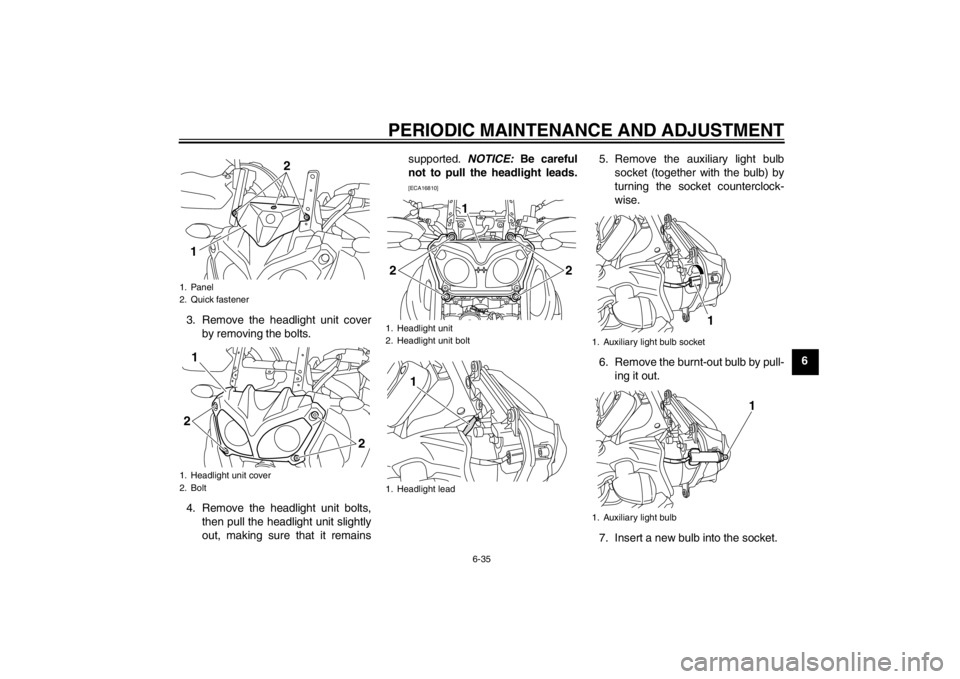
PERIODIC MAINTENANCE AND ADJUSTMENT
6-35
6
3. Remove the headlight unit cover
by removing the bolts.
4. Remove the headlight unit bolts, then pull the headlight unit slightly
out, making sure that it remains supported.
NOTICE: Be careful
not to pull the headlight leads.
[ECA16810]
5. Remove the auxiliary light bulb socket (together with the bulb) by
turning the socket counterclock-
wise.
6. Remove the burnt-out bulb by pull- ing it out.
7. Insert a new bulb into the socket.
1. Panel
2. Quick fastener
1. Headlight unit cover
2. Bolt
2
1
2
2 1
1. Headlight unit
2. Headlight unit bolt
1. Headlight lead
1
2
2
1
1. Auxiliary light bulb socket
1. Auxiliary light bulb
1
1
U23PE3E0.book Page 35 Monday, July 30, 2012 8:44 AM
Page 92 of 108
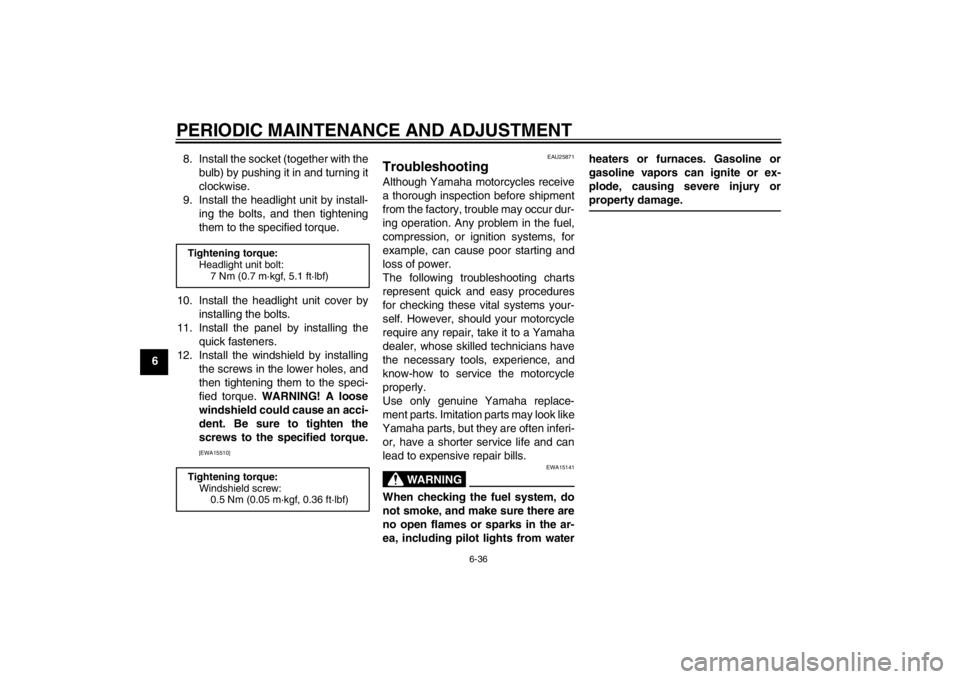
PERIODIC MAINTENANCE AND ADJUSTMENT
6-36
68. Install the socket (together with the
bulb) by pushing it in and turning it
clockwise.
9. Install the headlight unit by install- ing the bolts, and then tightening
them to the specified torque.
10. Install the headlight unit cover by installing the bolts.
11. Install the panel by installing the quick fasteners.
12. Install the windshield by installing the screws in the lower holes, and
then tightening them to the speci-
fied torque. WARNING! A loose
windshield could cause an acci-
dent. Be sure to tighten the
screws to the specified torque.
[EWA15510] EAU25871
Troubleshooting Although Yamaha motorcycles receive
a thorough inspection before shipment
from the factory, trouble may occur dur-
ing operation. Any problem in the fuel,
compression, or ignition systems, for
example, can cause poor starting and
loss of power.
The following troubleshooting charts
represent quick and easy procedures
for checking these vital systems your-
self. However, should your motorcycle
require any repair, take it to a Yamaha
dealer, whose skilled technicians have
the necessary tools, experience, and
know-how to service the motorcycle
properly.
Use only genuine Yamaha replace-
ment parts. Imitation parts may look like
Yamaha parts, but they are often inferi- or, have a shorter service life and can
lead to expensive repair bills.
WARNING
EWA15141
When checking the fuel system, do
not smoke, and make sure there are
no open flames or sparks in the ar-
ea, including pilot lights from water heaters or furnaces. Gasoline or
gasoline vapors can ignite or ex-
plode, causing severe injury or
property damage.
Tightening torque:
Headlight unit bolt:7 Nm (0.7 m·kgf, 5.1 ft·lbf)
Tightening torque: Windshield screw:0.5 Nm (0.05 m·kgf, 0.36 ft·lbf)
U23PE3E0.book Page 36 Monday, July 30, 2012 8:44 AM
Page 95 of 108
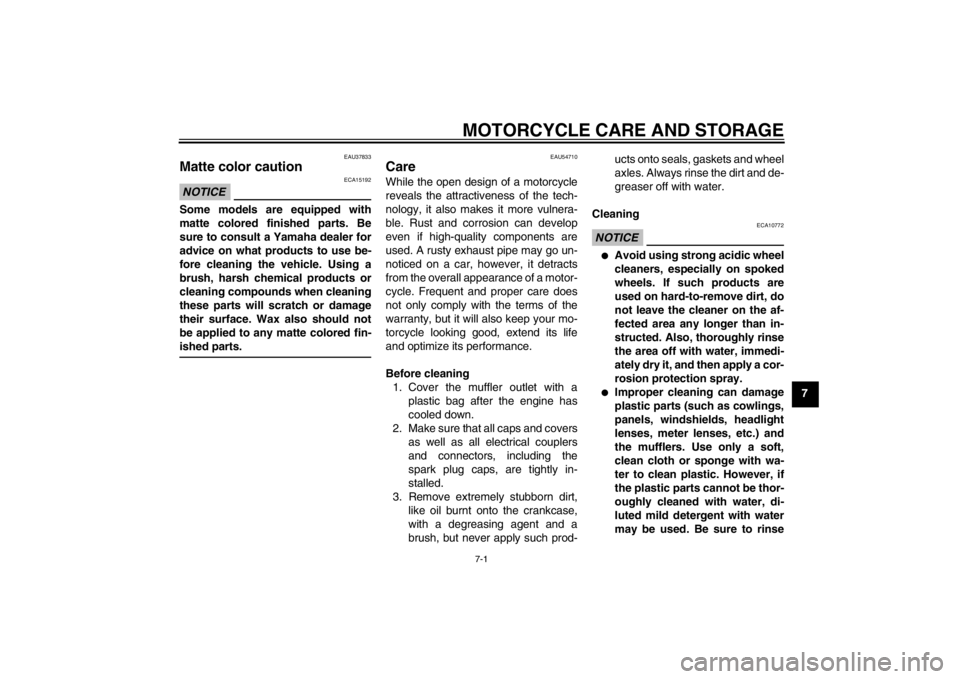
MOTORCYCLE CARE AND STORAGE
7-1
7
EAU37833
Matte color caution NOTICE
ECA15192
Some models are equipped with
matte colored finished parts. Be
sure to consult a Yamaha dealer for
advice on what products to use be-
fore cleaning the vehicle. Using a
brush, harsh chemical products or
cleaning compounds when cleaning
these parts will scratch or damage
their surface. Wax also should not
be applied to any matte colored fin-
ished parts.
EAU54710
Care While the open design of a motorcycle
reveals the attractiveness of the tech-
nology, it also makes it more vulnera-
ble. Rust and corrosion can develop
even if high-quality components are
used. A rusty exhaust pipe may go un-
noticed on a car, however, it detracts
from the overall appearance of a motor-
cycle. Frequent and proper care does
not only comply with the terms of the
warranty, but it will also keep your mo-
torcycle looking good, extend its life
and optimize its performance.
Before cleaning1. Cover the muffler outlet with a plastic bag after the engine has
cooled down.
2. Make sure that all caps and covers as well as all electrical couplers
and connectors, including the
spark plug caps, are tightly in-
stalled.
3. Remove extremely stubborn dirt, like oil burnt onto the crankcase,
with a degreasing agent and a
brush, but never apply such prod- ucts onto seals, gaskets and wheel
axles. Always rinse the dirt and de-
greaser off with water.
Cleaning
NOTICE
ECA10772
●
Avoid using strong acidic wheel
cleaners, especially on spoked
wheels. If such products are
used on hard-to-remove dirt, do
not leave the cleaner on the af-
fected area any longer than in-
structed. Also, thoroughly rinse
the area off with water, immedi-
ately dry it, and then apply a cor-
rosion protection spray.
●
Improper cleaning can damage
plastic parts (such as cowlings,
panels, windshields, headlight
lenses, meter lenses, etc.) and
the mufflers. Use only a soft,
clean cloth or sponge with wa-
ter to clean plastic. However, if
the plastic parts cannot be thor-
oughly cleaned with water, di-
luted mild detergent with water
may be used. Be sure to rinse
U23PE3E0.book Page 1 Monday, July 30, 2012 8:44 AM
Page 96 of 108
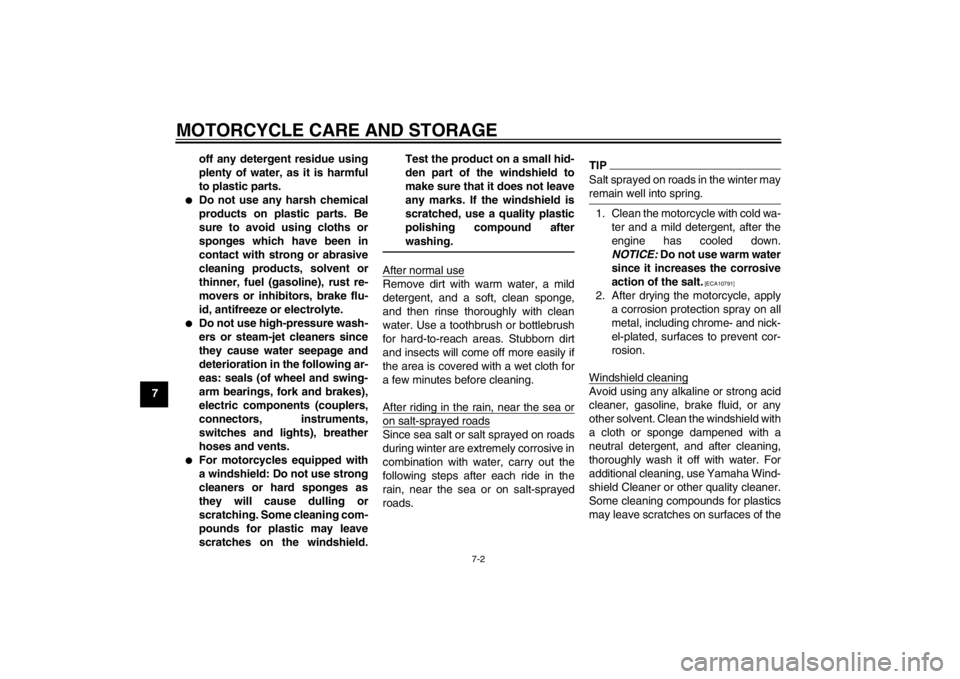
MOTORCYCLE CARE AND STORAGE
7-2
7off any detergent residue using
plenty of water, as it is harmful
to plastic parts.
●
Do not use any harsh chemical
products on plastic parts. Be
sure to avoid using cloths or
sponges which have been in
contact with strong or abrasive
cleaning products, solvent or
thinner, fuel (gasoline), rust re-
movers or inhibitors, brake flu-
id, antifreeze or electrolyte.
●
Do not use high-pressure wash-
ers or steam-jet cleaners since
they cause water seepage and
deterioration in the following ar-
eas: seals (of wheel and swing-
arm bearings, fork and brakes),
electric components (couplers,
connectors, instruments,
switches and lights), breather
hoses and vents.
●
For motorcycles equipped with
a windshield: Do not use strong
cleaners or hard sponges as
they will cause dulling or
scratching. Some cleaning com-
pounds for plastic may leave
scratches on the windshield. Test the product on a small hid-
den part of the windshield to
make sure that it does not leave
any marks. If the windshield is
scratched, use a quality plastic
polishing compound after
washing.
After normal useRemove dirt with warm water, a mild
detergent, and a soft, clean sponge,
and then rinse thoroughly with clean
water. Use a toothbrush or bottlebrush
for hard-to-reach areas. Stubborn dirt
and insects will come off more easily if
the area is covered with a wet cloth for
a few minutes before cleaning.
After riding in the rain, near the sea oron salt-sprayed roadsSince sea salt or salt sprayed on roads
during winter are extremely corrosive in
combination with water, carry out the
following steps after each ride in the
rain, near the sea or on salt-sprayed
roads.
TIPSalt sprayed on roads in the winter may
remain well into spring.1. Clean the motorcycle with cold wa-
ter and a mild detergent, after the
engine has cooled down.
NOTICE: Do not use warm water
since it increases the corrosive
action of the salt.
[ECA10791]
2. After drying the motorcycle, apply a corrosion protection spray on all
metal, including chrome- and nick-
el-plated, surfaces to prevent cor-
rosion.
Windshield cleaningAvoid using any alkaline or strong acid
cleaner, gasoline, brake fluid, or any
other solvent. Clean the windshield with
a cloth or sponge dampened with a
neutral detergent, and after cleaning,
thoroughly wash it off with water. For
additional cleaning, use Yamaha Wind-
shield Cleaner or other quality cleaner.
Some cleaning compounds for plastics
may leave scratches on surfaces of the
U23PE3E0.book Page 2 Monday, July 30, 2012 8:44 AM